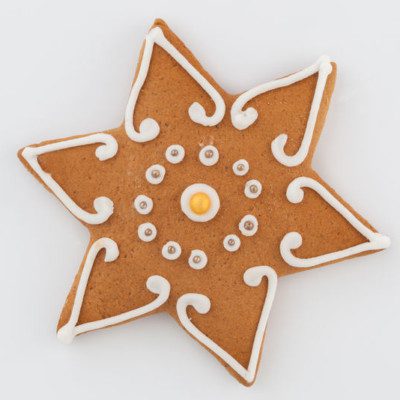Gingerbread was a luxury in Medieval Europe as most of the ingredients were imported sugars and spices. So prized were the breads that towns had their own recipes and guilds also formed. The sweet became strongly associated with religious holidays, including Christmas and Easter.
Queen Elizabeth I is credited as originating the tradition of elaborately decorating gingerbread cookies after commissioning human-shaped cookies to look like dignitaries visiting her court.¹
The English version relied on stale white bread to which cinnamon, ginger, “licoras” and aniseed were mixed along with sugar and claret. Sweetener use and preferences evolved with bakers eventually opting for treacle and/or molasses. Originally, when leavened, a sourdough-like starter was used. The dough was typically formed in elaborate molds and finished with gold leaf.⁵
When gingerbread came to the Americas, it was equally prized. However, a softer, cake-like gingerbread was preferred. One recipe—traced to George Washington’s mother, Mary Ball Washington—came to be known as Gingerbread Lafayette as it had been served to the Marquis de Lafayette on a visit to Virginia.¹
Today, gingerbread items are traditionally made and enjoyed between Thanksgiving and New Year in North America. During this period gingerbread-inspired holiday treats abound and can even be found as coffee flavoring, sweet peanut-butter-substitute spreads, or ice cream.
Function
“This is a favourite article with many nations,” stated George Read in his 1854 treatise on the topic.³ Breads made with barley or rye were sweetened with honey or sugar and spices were added. In an ancient French version, “when baked, the top was washed over with the scum taken off sugar in refining houses.
“The taste for this sort of bread appears to have been univesal [sic], but carried to the most excess in Holland, where it is considered the best sort is made.”
John Kirkland’s 1907 commercial baking series explains the chemistry of gingerbread making in detail.⁴ Yeast was not used in the sweet-laden cakes since “the yeast plant cannot thrive and ferment properly. … It was long ago discovered, however, that if pearlash was added to the treacle or other syrup material before putting into the flour, the doughs so made, after keeping for a time, which may vary from two days to nearly twelve months, would be partly aerated, and turn out good gingerbreads or honey cakes as the case might be. This is the basis of the Dutch and German methods of honey-cake making, and also that of gingerbread production in this country.”
Advances in technology and the wider availability of commercially-refined ingredients changed the way foods, including gingerbread, were made.⁷
Formula
Gingerbread can be enjoyed in many forms, but cookies are one popular item.
Ginger Molasses Cookie Recipe:⁸
| Ingredients | |
| Butter | 44.67 |
| Brown Sugar | 71.32 |
| Eggs | 7.84 |
| Molasses | 26.65 |
| Bread Flour | 100 |
| Baking Soda | 2.51 |
| Salt | 1.1 |
| Ground Gloves | 0.63 |
| Ground Cinnamon | 0.94 |
| Ground Ginger | 0.94 |
| Ground Nutmeg | 0.47 |
| Ground Allspice | 0.31 |
| Total | 257.38 |
Method
- Cream butter and sugar until well combined.
- Add eggs and then the molasses.
- Add the dry ingredients and mix until well incorporated.
- Scale into 2 lb, 3 oz./1000 g pieces and roll into 17 inch/43 cm logs (sheet pan width).
- Wrap each log in parchment and refrigerate until ready to bake
- Cut to the desired size [2 oz./50 g to 4 oz./100 g]; place on parchment-lined sheet pans and bake at 350°F/177°C in a convection oven for 12 to 15 minutes.
Application
Recipes for commercial gingerbread vary widely. Yet from stiff paste used to make square cakes to modern cookies, all are based around spices and sweetener. Ginger has been incorporated in powdered, crystallized, or even fresh form. A wide variety of sweeteners have been employed, beginning with honey. Molasses, brown sugar, and golden syrup have been used to make cakes and cookies ranging in color from dark to golden brown.²
Spices have variously included coriander seed, caraway, cloves, rose water syrup, fennel seed, and aniseseed or even pepper. At some point, treacle was used and candied orange, lemon, citron and ginger were added to the base dough, which often was formed using some combination of potash, volatile salt and alum or acid.
A different recipe is needed for architectural baking with gingerbread. Stiff, unleavened gingerbread is required to construct houses and confectionery dioramas for the winter holidays. Typically, the dough is cut and shaped before it is baked. When leavening is present, the dough will spread while baking, which changes the shape and makes it difficult to construct displays as planned.⁶
References
- Avey, Tori. “The History of Gingerbread.” PBS, Public Broadcasting Service, 20 Dec. 2013, https://www.pbs.org/food/stories/history-gingerbread. Last accessed 23 October 2018.
- McGlinn, Jennifer Lindner. Gingerbread. Chronicle Books, 2010.
- Read, George. The Complete Biscuit and Gingerbread Baker’s Assistant. Dean and Son, 1854. pp. 83-96.
- Kirkland, John, editor. “The Modern Baker, Confectioner and Caterer; a Practical and Scientific Work for the Baking and Allied Trades, ” The Modern Baker, Confectioner and Caterer; a Practical and Scientific Work for the Baking and Allied Trades., vol. 2, London Gresham Pub. Co, 1907.
- Levene, Alysa. “Chapter 2: The Secret Meaning of Fruit Cake.” Cake: A Slice of History, Pegasus Books, 2016.
- Kelly, Debra. “Mistakes Everyone Makes When Making Gingerbread.” Mashed.com, Mashed, 22 Feb. 2018, www.mashed.com/34087/mistakes-everyone-makes-making-gingerbread/?utm_campaign=clip. Last accessed 23 October 2018.
- “New York Gingerbread, 1899,” A Dollop of History, 13 November 2017, https://historydollop.com/2017/11/13/new-york-gingerbread-1899/. Last accessed 23 October 2018.
- Suas, Michel. Advanced Bread and Pastry – A Professional Approach. San Francisco Baking Industry (publisher) 2009. p. 418.

